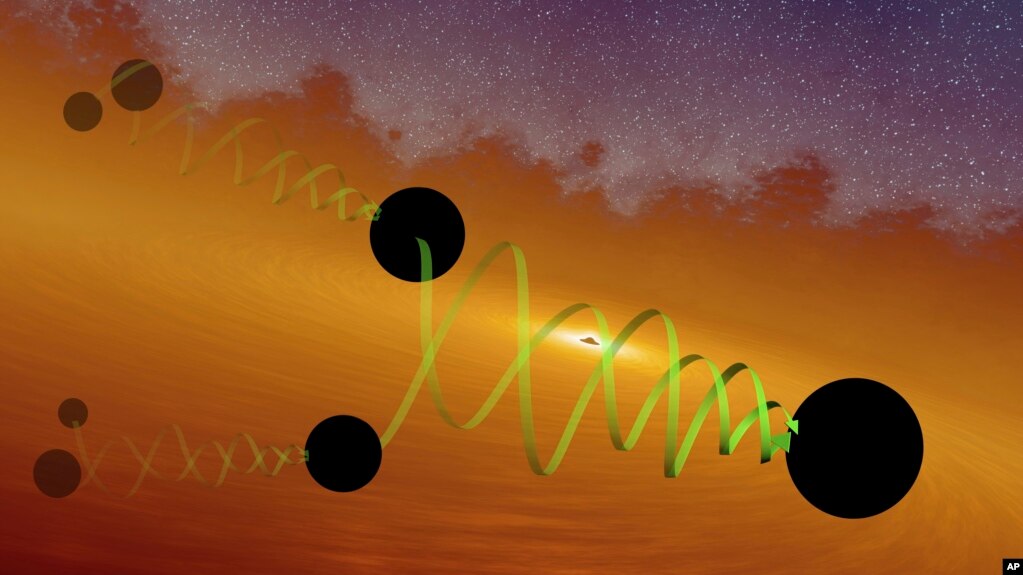2019年4月10日、「世界で初めてブラックホールの影を撮影することに成功した」と、日本などの国際研究チームが発表したのです。
- ブラックホールが異常な大きさに合体
- ブラックホール
- 国立科学博物館-宇宙の質問箱-宇宙論編
- 【ノーカット】世界初ブラックホール撮影成功 国立天文台などのチームが会見
- Black Holes Merge Into Unusual Size
ブラックホールが異常な大きさに合体
Black Holes Merge Into Unusual Size
ブラックホールは、宇宙空間にある惑星やその他の物体を研究する科学者にとっても、ますます奇妙な存在になってきています。
天文学者たちは最近、2つのブラックホールの激しい衝突による信号の発見を報告しました。この出来事は、ずっと前に起きたもので、科学者たちがこれまで見たことのない大きさの新しいブラックホールが誕生したのです。
カリフォルニア工科大学の物理学者アラン・ワインスタイン氏は発見チームの一員でした。彼は、今回の発見はビッグバン以来、人類が観測した”最大級のビッグバン”であると指摘してます。
ビッグバンとは、多くの天文学者が宇宙の始まりを説明するために使う言葉です。
ブラックホールは宇宙の小型な領域です。ブラックホールは、光さえも逃げることができないほど密集しています。最近まで、天文学者たちは、ブラックホールの大きさを2つに分けて観測していました。
1つは、恒星ブラックホールと呼ばれる”小さな”ブラックホールです。このブラックホールは、星が崩壊してできたものです。その大きさは、小さな街の大きさくらいです。
また、超巨大ブラックホールもあります。これらのブラックホールは、太陽の数百万倍から数十億倍の質量を持っています。
天文学者の計算によると、この2つの大さには意味がないことがわかりました。それは、崩壊する前に大きくなりすぎた星は、一般的に自壊してブラックホールを残さないからです。
ネルソン・クリステンセン氏は、フランス国立科学研究センターの研究ディレクターです。彼は、科学者たちは、星の崩壊では私たちの太陽の70倍の質量よりもはるかに大きい恒星ブラックホールを形成することができないと考えていたと言います。
そして2019年5月、2つのセンサーが互いに衝突する2つの恒星ブラックホールからのエネルギーであることが判明した信号を受信しました。1つは太陽の66倍の質量でした。もう一つは太陽の85倍の質量でした。
その結果: 太陽の142倍の質量を持つインターミディアトブラックホールが初めて発見されました。インターミディアトという言葉は、プロセスや開発の途中であることを意味しています。
衝突により、大量のエネルギーが失われたのです。そのエネルギーは重力波の形をしており、光速で移動する空間のさざ波でした。
昨年、欧米の物理学者たちが 獅子座と乙女座 と呼ばれる検出器を使って捉えたのは、その波だったのです。信号を研究し、彼らの仕事を再検討した後、科学者たちは今週、物理学レビュー レターズとアストロフィジカル ジャーナル レターズで結果を発表しました。
検出器が重力波を音声信号として受信するので、科学者たちは実際に衝突を聞いたのです。すべての破壊的力のために、信号は10分の1秒しか持続しませんでした。
「それはただのドスンという音のように聞こえるのです」「スピーカーではあまり聞こえません」とワインスタイン氏は言います。
この衝突は約70億年前、宇宙が現在の約半分の年齢だった頃に起こりました。衝突が非常に遠かったため、今になって初めて検出されたのです。
ブラックホールの衝突は以前にも観測されています。しかし、衝突したブラックホールはもともと小さかったのです。衝突後も、通常の恒星ブラックホールの大きさを超えることはありませんでした。
科学者は銀河の中心にある超巨大ブラックホールがどのようにして形成されたのかをいまだ分かってはいないが、今回の新発見はその手掛かりになるかもしれないとクリステンセン氏は話しています。
ブラックホール
国立科学博物館-宇宙の質問箱-宇宙論編

重力が大きすぎて、そこから光でさえも逃げだしてくることができない天体のこと。
天体の表面での重力の大きさは、その天体の質量に比例しており、天体の質量が大きいほど大きくなります。また同時に、天体の大きさの二乗に反比例しています。つまり、天体が小さければ小さいほど、重力は大きくなるのです。そうすると、ある天体をぎゅっと押し縮めて、小さくすると、その表面の重力が大きくなり、脱出速度が光の速さより速くなって、ブラックホールができるでしょう。私たちの太陽を押し縮めて、直径6kmの球にしたとすれば、太陽はブラックホールになってしまいます。
ブラックホールを相対性理論で説明すると、それは空間のゆがみと考えることもできます。たとえば、広くはられたうすいゴムのシートを考えてみます。このゴムの上に何か物、たとえばビー玉をおいてみましょう。すると、ビー玉をおいたところが少しへこみ、そのへこみはビー玉のまわりに広がっているでしょう。これが空間のゆがみだと考えて下さい、ブラックホールのあるところでは、強い重力で空間がゆがみ、まるで空間にあながあいているようだともいえます。あなの近くにさしかかつた天体は、その強い重力にとらえられて、このあなに落ちていきます。光でさえも逃げ出すことができないほど強い重力で切り立ったあな、それが相対性理論でみたブラックホールなのです。
ブラックホールとは、密度が非常に高く、強力な重力場を持つ天体です。光でさえもその重力場から出てくることできないので、ブラックホール自身は光を出しません。ですから直接観測はできませんが、ブラックホールに吸い込まれるガスが超高温になり、X線などのエネルギーを放出して明るく輝きますので、それがブラックホールの存在を教えてくれます。
【ノーカット】世界初ブラックホール撮影成功 国立天文台などのチームが会見
Black Holes Merge Into Unusual Size
 This illustration provided by LIGO/Caltech in September 2020 depicts two black holes of about 66 and 85 solar masses spiralling into each other to form the GW190521 black hole
This illustration provided by LIGO/Caltech in September 2020 depicts two black holes of about 66 and 85 solar masses spiralling into each other to form the GW190521 black hole
Black holes are becoming stranger — even to scientists who study planets and other objects in outer space.
Astronomers recently reported the discovery of the signal from a violent collision of two black holes. The event, which took place long ago, created a new black hole of a size that scientists had never seen before.
California Institute of Technology physicist Alan Weinstein was part of the discovery team. He noted that the finding was the “biggest bang” ever observed by human beings since the Big Bang.
The Big Bang is a term many astronomers use to explain the beginning of the universe.
Black holes are compact areas of space. They are so dense that not even light can escape. Until recently, astronomers had observed them in two general sizes.
There are “small” ones called stellar black holes. These black holes are formed when a star collapses. They are about the size of a small city.
There are also supermassive black holes. These black holes are millions, maybe billions, of times more massive than our sun.
Astronomers’ calculations suggest that anything in between the two sizes did not make sense. That was because stars that grew too big before collapse would generally destroy themselves, leaving no black holes.
Nelson Christensen is research director of the French National Centre for Scientific Research. He says scientists thought that star collapses could not create stellar black holes much bigger than 70 times the mass of our sun.
Then in May 2019 two sensors received a signal that turned out to be the energy from two stellar black holes crashing into each other. One was 66 times the mass of our sun. The other was 85 times the mass of the sun.
The result: The first ever discovered intermediate black hole, at 142 times the mass of the sun. The word intermediate suggests being in the middle of a process or development.
In the collision, a large amount of energy was lost. The energy was in the form of a gravitational wave, a ripple in space that travels at the speed of light.
It was that wave that physicists in the United States and Europe, using detectors called LIGO and Virgo, captured last year. After studying the signal and reexamining their work, scientists published the results this week in Physical Review Letters and Astrophysical Journal Letters.
Because the detectors receive the gravitational waves as audio signals, scientists actually heard the collision. For all the violence, the signal lasted only one-tenth of a second.
“It just sounds like a thud,” Weinstein said. “It really doesn’t sound like much on a speaker.”
This crash happened about 7 billion years ago, when the universe was about half its current age. It was only detected now because the collision was so far away.
Black hole collisions have been observed before. But the black holes involved were smaller to begin with. Even after the collision, they did not grow beyond the size of normal stellar black holes.
Scientists still do not know how supermassive black holes at the center of galaxies formed, Christensen said, but this new discovery may offer a clue.
_____________________________________________________________
Words in This Story
collision – n. an act of colliding, such as a crash in which two or more things or people hit each other
bang – n. a sudden, loud noise
compact – adj. closely or firmly joined together
calculation – n. an estimate or prediction
ripple – n. something that passes or spreads through or over someone or something; a shape having small waves
detector – n. a device that can tell if a substance or object is present; a device that measures the presence of something
thud – n. a loud sound made especially when a heavy object hits something